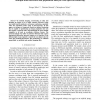Free Online Productivity Tools
i2Speak
i2Symbol
i2OCR
iTex2Img
iWeb2Print
iWeb2Shot
i2Type
iPdf2Split
iPdf2Merge
i2Bopomofo
i2Arabic
i2Style
i2Image
i2PDF
iLatex2Rtf
Sci2ools
ICPR
2010
IEEE
2010
IEEE
Multiple Atlas Inference and Population Analysis with Spectral Clustering
In medical imaging, constructing an atlas and bringing an image set in a single common reference frame may easily lead the analysis to erroneous conclusions, especially when the population under study is heterogeneous. In this paper, we propose a framework based on spectral clustering that is capable of partitioning an image population into sets that require a separate atlas, and identifying the most suitable templates to be used as coordinate reference frames. The spectral analysis step relies on pairwise distances that express anatomical differences between subjects as a function of the diffeomorphic warp required to match the one subject onto the other, plus residual information. The methodology is validated numerically on artificial and medical imaging data.
| Added | 30 Aug 2010 |
| Updated | 30 Aug 2010 |
| Type | Conference |
| Year | 2010 |
| Where | ICPR |
| Authors | Giorgos Sfikas, Christian Heinrich, Christophoros Nikou |
Comments (0)

